Voting-Based Deep Convolutional Neural Networks (VB-DCNNs) for M-QAM and M-PSK Signals Classification
Abstract
1. Introduction
- The likelihood function-based decision-theoretic (DT) approach;
- The features-based pattern recognition (PR) approach.
1.1. Contribution of This Paper
- The major goal is to automatically classify modulated signals using a voting-based deep convolutional neural network (VB-DCNN).
- The VB-DCNN does not require prior knowledge of the symbol rate or baud rate. Therefore, it reduces the testing framework’s execution requirements, improving classification and processing efficiency.
- In the VB-DCNN, the size of the input signal is fixed for classification, but the length of the actual signal is flexible. It is intended to use the complete input signal burst to increase classification accuracy further.
1.2. Organization of This Paper
2. Related Work
3. System Model
4. Voting-Based DCNN
4.1. Deep Convolutional Neural Network
4.2. Voting-Based Fusion
| Algorithm 1: VB-DCNN classifier. |
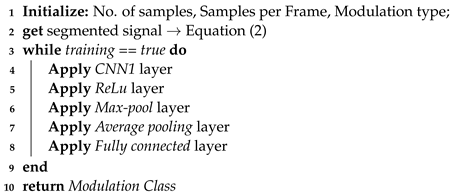 |
4.3. Computational Complexity of VB-DCNN
5. Simulation Results
- Case-I: M-PSK and MFSK signals;
- Case-II: M-QAM signals;
- Case-III: nine modulated signals.
5.1. Case-I: BPSK, QPSK, 8 PSK, 256 PSK, GFSK, CPFSK
5.2. Case-II: 4 QAM, 8 QAM, 16 QAM, 256 QAM
5.3. Case-III: Nine Modulated Signals
5.4. Performance Evaluation with Different Layers
5.5. VB-DCNN Performance Evaluation on Fading Channels
5.6. Relationship Training and Testing Accuracy
5.7. Comparative Analysis of VB-DCNN
6. Conclusions
Author Contributions
Funding
Institutional Review Board Statement
Informed Consent Statement
Data Availability Statement
Conflicts of Interest
Notation
| (n) | Fading Coefficients |
| Length of Segmented Signal | |
| i-th Classification Class | |
| Voting-based Fusion | |
| L | length of the signal |
References
- Zhu, Z.; Nandi, A.K. Automatic Modulation Classification: Principles, Algorithms and Applications; John Wiley & Sons: Hoboken, NJ, USA, 2015. [Google Scholar]
- Mahmood, A.; Ahmed, A.; Naeem, M.; Amirzada, M.R.; Al-Dweik, A. Weighted utility aware computational overhead minimization of wireless power mobile edge cloud. Comput. Commun. 2022, 190, 178–189. [Google Scholar] [CrossRef]
- Sarfraz, M.; Alam, S.; Ghauri, S.A.; Mahmood, A.; Akram, M.N.; Rehman, M.; Sohail, M.F.; Kebedew, T.M. Random Graph-Based M-QAM Classification for MIMO Systems. Wirel. Commun. Mob. Comput. 2022, 2022, 9419764. [Google Scholar] [CrossRef]
- Wang, T.; Wen, C.K.; Jin, S.; Li, G.Y. Deep learning-based CSI feedback approach for time-varying massive MIMO channels. IEEE Wirel. Commun. Lett. 2018, 8, 416–419. [Google Scholar] [CrossRef]
- Wang, F.; Huang, S.; Wang, H.; Yang, C. Automatic modulation classification exploiting hybrid machine learning network. Math. Probl. Eng. 2018, 2018, 6152010. [Google Scholar] [CrossRef]
- Khan, W.U.; Lagunas, E.; Mahmood, A.; Chatzinotas, S.; Ottersten, B. When RIS meets geo satellite communications: A new optimization framework in 6G. arXiv 2022, arXiv:2202.00497. [Google Scholar]
- Ullah Khan, W.; Lagunas, E.; Mahmood, A.; Chatzinotas, S.; Ottersten, B. Integration of Backscatter Communication with Multi-cell NOMA: A Spectral Efficiency Optimization under Imperfect SIC. arXiv 2021, arXiv:2109.11509. [Google Scholar]
- Akeela, R.; Dezfouli, B. Software-defined Radios: Architecture, state-of-the-art, and challenges. Comput. Commun. 2018, 128, 106–125. [Google Scholar] [CrossRef]
- Bany Muhammad, N.; Ghauri, S.; Sarfraz, M.; Munir, S. Genetic algorithm assisted support vector machine for M-QAM classification. Math. Model. Eng. Probl. 2020, 7, 441–449. [Google Scholar]
- Wu, P.; Sun, B.; Su, S.; Wei, J.; Zhao, J.; Wen, X. Automatic modulation classification based on deep learning for software-defined radio. Math. Probl. Eng. 2020, 2020, 2678310. [Google Scholar] [CrossRef]
- Abu-Romoh, M.; Aboutaleb, A.; Rezki, Z. Automatic modulation classification using moments and likelihood maximization. IEEE Commun. Lett. 2018, 22, 938–941. [Google Scholar] [CrossRef]
- Aksoy, G.; Karabatak, M. Performance Comparison of New Fast Weighted Naïve Bayes Classifier with Other Bayes Classifiers. In Proceedings of the 2019 7th International Symposium on Digital Forensics and Security (ISDFS), Barcelos, Portugal, 10–12 June 2019; IEEE: Piscataway, NJ, USA, 2019; pp. 1–5. [Google Scholar]
- O’Shea, T.J.; Roy, T.; Clancy, T.C. Over-the-air deep learning based radio signal classification. IEEE J. Sel. Top. Signal Process. 2018, 12, 168–179. [Google Scholar] [CrossRef]
- Rajendran, S.; Meert, W.; Giustiniano, D.; Lenders, V.; Pollin, S. Deep learning models for wireless signal classification with distributed low-cost spectrum sensors. IEEE Trans. Cogn. Commun. Netw. 2018, 4, 433–445. [Google Scholar] [CrossRef]
- Ren, Y.; Jiang, W.; Liu, Y. Complex-valued Parallel Convolutional Recurrent Neural Networks for Automatic Modulation Classification. In Proceedings of the 2022 IEEE 25th International Conference on Computer Supported Cooperative Work in Design (CSCWD), Hangzhou, China, 4–6 May 2022; IEEE: Piscataway, NJ, USA, 2022; pp. 804–809. [Google Scholar]
- Chen, K.; Zhang, J.; Chen, S.; Zhang, S.; Zhao, H. Automatic modulation classification of radar signals utilizing X-net. Digit. Signal Process. 2022, 123, 103396. [Google Scholar] [CrossRef]
- Fu, X.; Gui, G.; Wang, Y.; Gacanin, H.; Adachi, F. Automatic Modulation Classification Based on Decentralized Learning and Ensemble Learning. IEEE Trans. Veh. Technol. 2022, 71, 7942–7946. [Google Scholar] [CrossRef]
- Huang, S.; Yao, Y.; Wei, Z.; Feng, Z.; Zhang, P. Automatic modulation classification of overlapped sources using multiple cumulants. IEEE Trans. Veh. Technol. 2016, 66, 6089–6101. [Google Scholar] [CrossRef]
- Aslam, M.W.; Zhu, Z.; Nandi, A.K. Automatic modulation classification using combination of genetic programming and KNN. IEEE Trans. Wirel. Commun. 2012, 11, 2742–2750. [Google Scholar]
- Ramjee, S.; Ju, S.; Yang, D.; Liu, X.; Gamal, A.E.; Eldar, Y.C. Fast deep learning for automatic modulation classification. arXiv 2019, arXiv:1901.05850. [Google Scholar]
- Meng, F.; Chen, P.; Wu, L.; Wang, X. Automatic modulation classification: A deep learning enabled approach. IEEE Trans. Veh. Technol. 2018, 67, 10760–10772. [Google Scholar] [CrossRef]
- Ke, Z.; Vikalo, H. Real-time radio technology and modulation classification via an LSTM auto-encoder. IEEE Trans. Wirel. Commun. 2021, 21, 370–382. [Google Scholar] [CrossRef]
- Liu, X.; Yang, D.; El Gamal, A. Deep neural network architectures for modulation classification. In Proceedings of the 2017 51st Asilomar Conference on Signals, Systems, and Computers, Pacific Grove, CA, USA, 29 October–1 November 2017; IEEE: Piscataway, NJ, USA, 2017; pp. 915–919. [Google Scholar]
- West, N.E.; O’Shea, T. Deep architectures for modulation recognition. In Proceedings of the 2017 IEEE International Symposium on Dynamic Spectrum Access Networks (DySPAN), Baltimore, MD, USA, 6–9 March 2017; IEEE: Piscataway, NJ, USA, 2017; pp. 1–6. [Google Scholar]
- Szegedy, C.; Liu, W.; Jia, Y.; Sermanet, P.; Reed, S.; Anguelov, D.; Erhan, D.; Vanhoucke, V.; Rabinovich, A. Going deeper with convolutions. In Proceedings of the IEEE Conference on Computer Vision and Pattern Recognition, Boston, MA, USA, 7–12 June 2015; pp. 1–9. [Google Scholar]
- Wang, N.; Liu, Y.; Ma, L.; Yang, Y.; Wang, H. Automatic Modulation Classification Based on CNN and Multiple Kernel Maximum Mean Discrepancy. Electronics 2022, 12, 66. [Google Scholar] [CrossRef]
- Elsagheer, M.M.; Ramzy, S.M. A hybrid model for automatic modulation classification based on residual neural networks and long short term memory. Alex. Eng. J. 2023, 67, 117–128. [Google Scholar] [CrossRef]
- Essai, M.H.; Atallah, H.A. Automatic Modulation Classification: Convolutional Deep Learning Neural Networks Approaches. SVU-Int. J. Eng. Sci. Appl. 2023, 4, 48–54. [Google Scholar]
- Xu, J.; Lin, Z. Modulation and Classification of Mixed Signals Based on Deep Learning. arXiv 2022, arXiv:2205.09916. [Google Scholar]
- Indira, N.D.; Rao, M.V.G. Deep Learning CNN-Based Hybrid Extreme Learning Machine with Bagging Classifier for Automatic Modulation Classification. Int. J. Intell. Syst. Appl. Eng. 2022, 10, 134–141. [Google Scholar]
- Ma, R.; Wu, D.; Hu, T.; Yi, D.; Zhang, Y.; Chen, J. Automatic Modulation Classification Based on One-Dimensional Convolution Feature Fusion Network. In Proceedings of the 2021 International Conference on Wireless Communications, Networking and Applications, Hangzhou, China, 13–15 August 2021; Springer: Berlin/Heidelberg, Germany, 2022; pp. 888–899. [Google Scholar]
- Zheng, S.; Qi, P.; Chen, S.; Yang, X. Fusion methods for CNN-based automatic modulation classification. IEEE Access 2019, 7, 66496–66504. [Google Scholar] [CrossRef]
- Triantaris, P.; Tsimbalo, E.; Chin, W.H.; Gündüz, D. Automatic modulation classification in the presence of interference. In Proceedings of the 2019 European Conference on Networks and Communications (EuCNC), Valencia, Spain, 18–21 June 2019; IEEE: Piscataway, NJ, USA, 2019; pp. 549–553. [Google Scholar]
- Zhang, H.; Wang, Y.; Xu, L.; Gulliver, T.A.; Cao, C. Automatic modulation classification using a deep multi-stream neural network. IEEE Access 2020, 8, 43888–43897. [Google Scholar] [CrossRef]
- Zhang, R.; Yin, Z.; Wu, Z.; Zhou, S. A novel automatic modulation classification method using attention mechanism and hybrid parallel neural network. Appl. Sci. 2021, 11, 1327. [Google Scholar] [CrossRef]
- Shah, S.I.H.; Coronato, A.; Ghauri, S.A.; Alam, S.; Sarfraz, M. CSA-Assisted Gabor Features for Automatic Modulation Classification. Circuits Syst. Signal Process. 2022, 41, 1660–1682. [Google Scholar] [CrossRef]

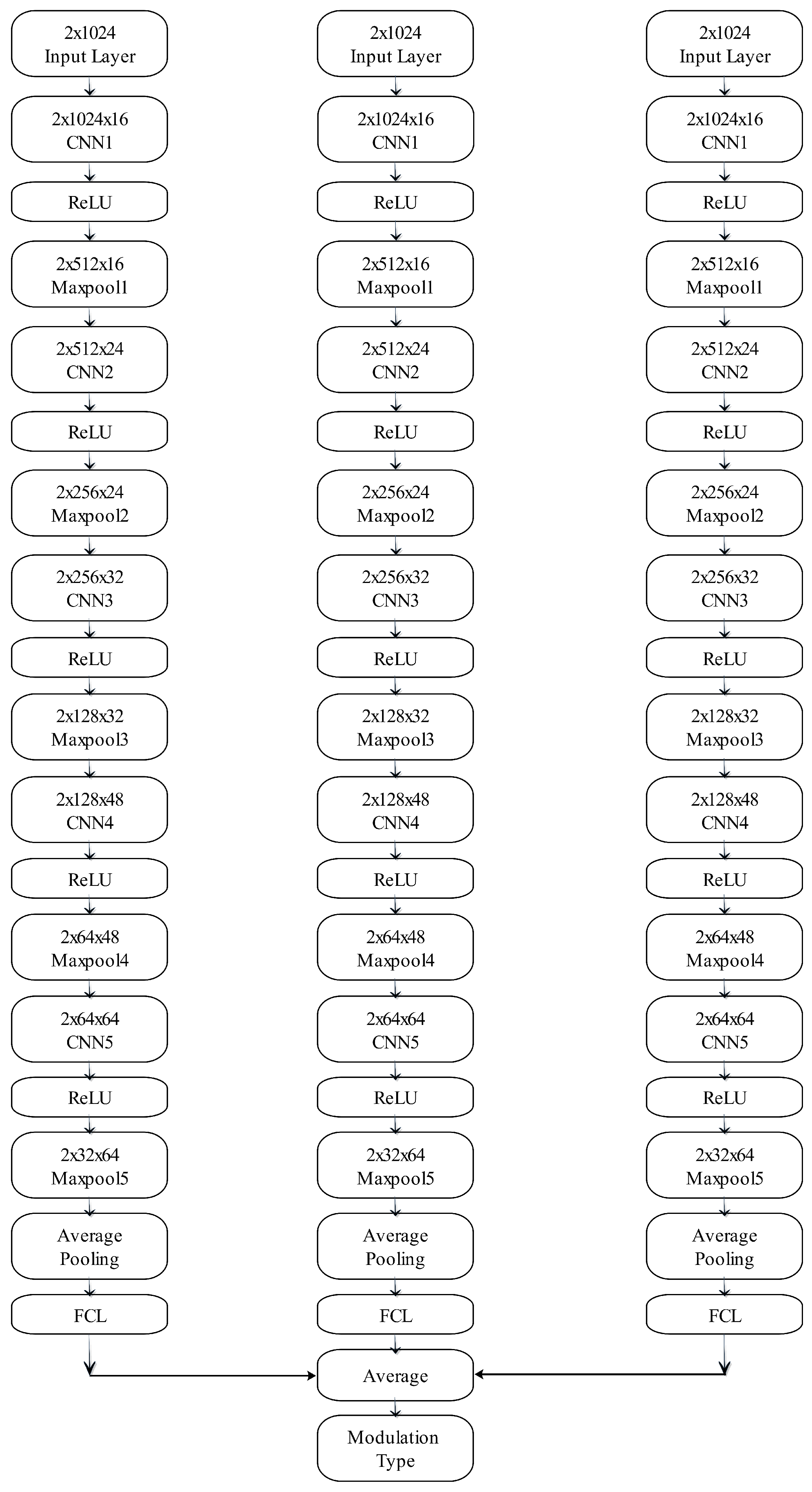
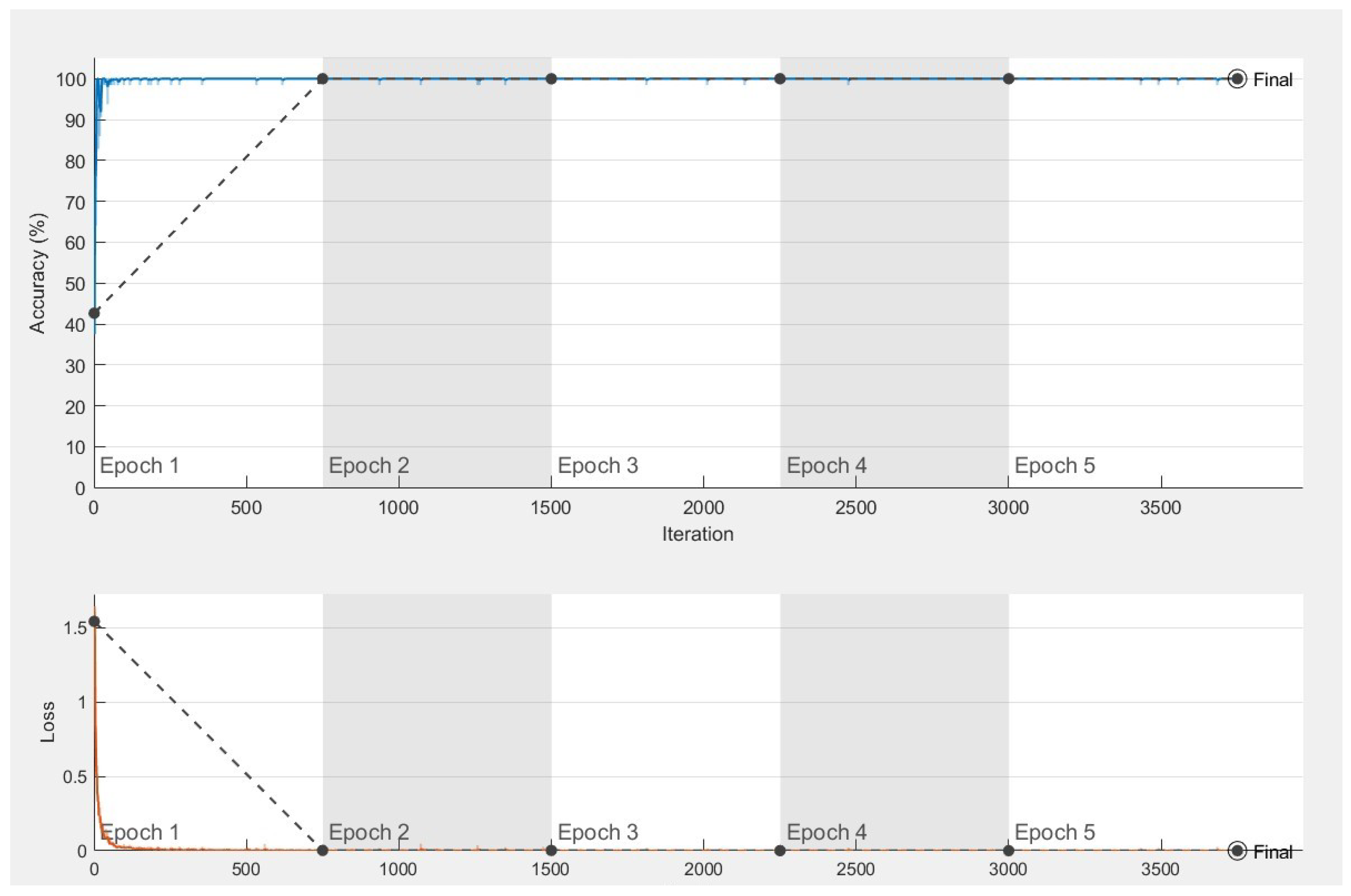
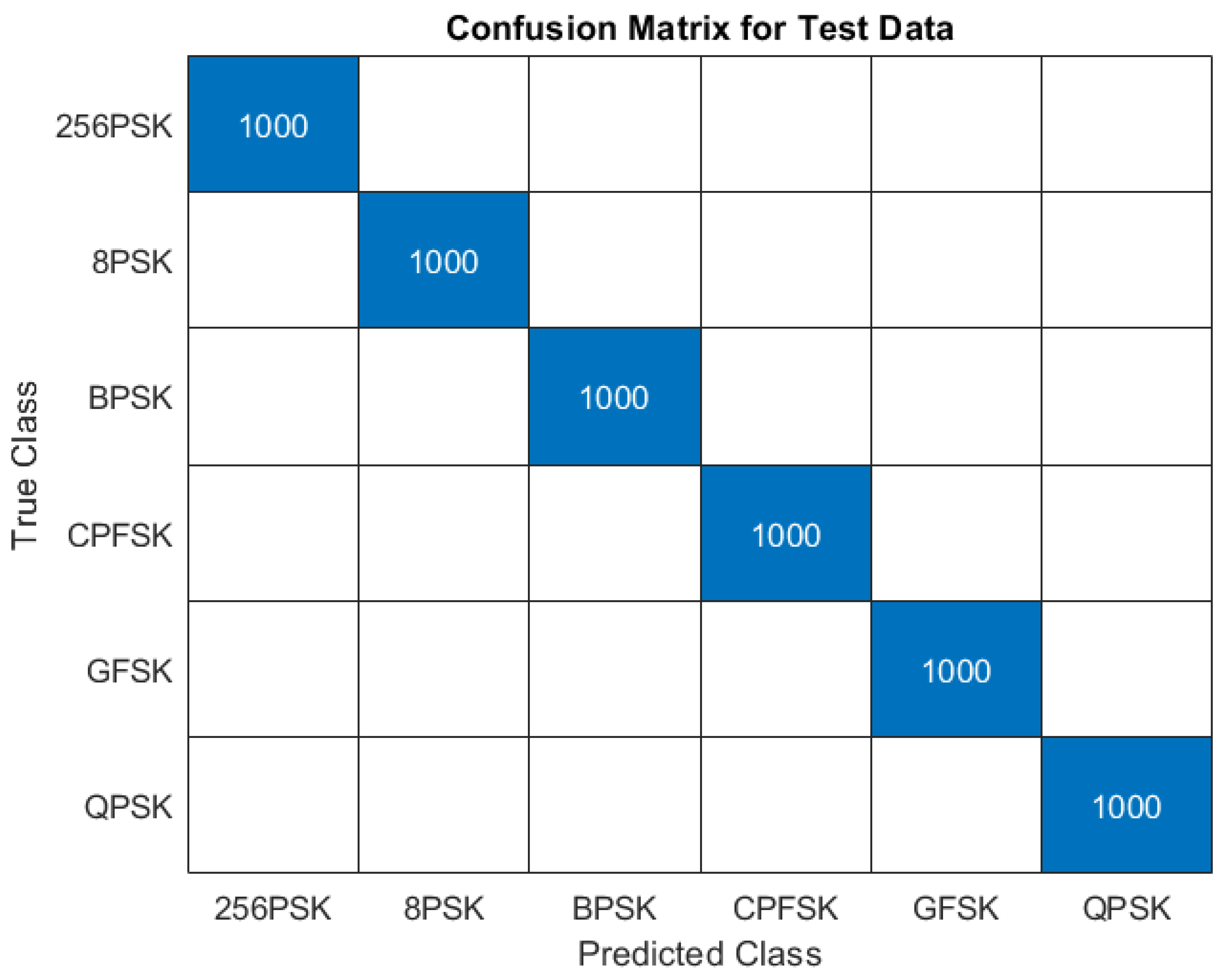
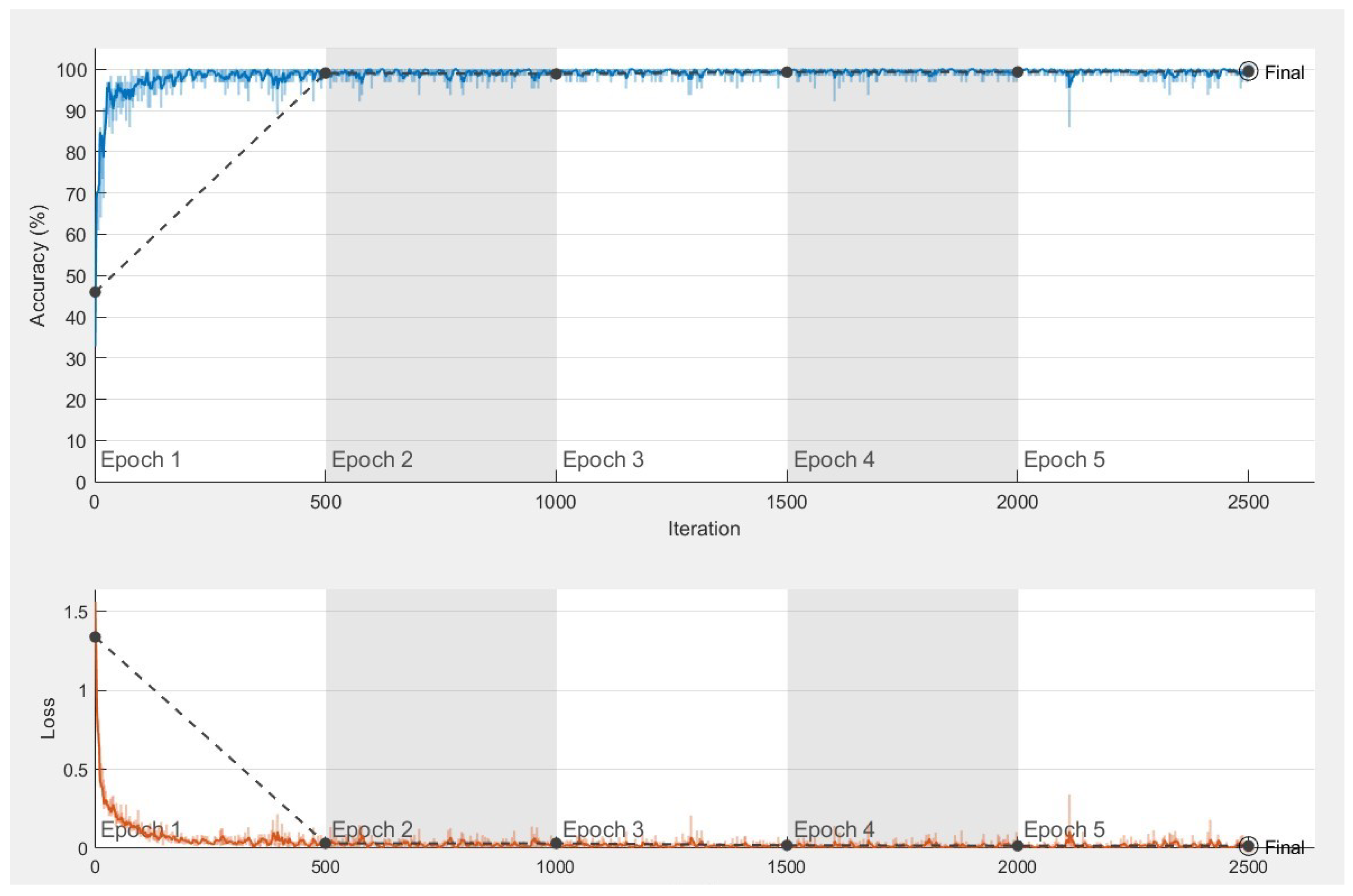
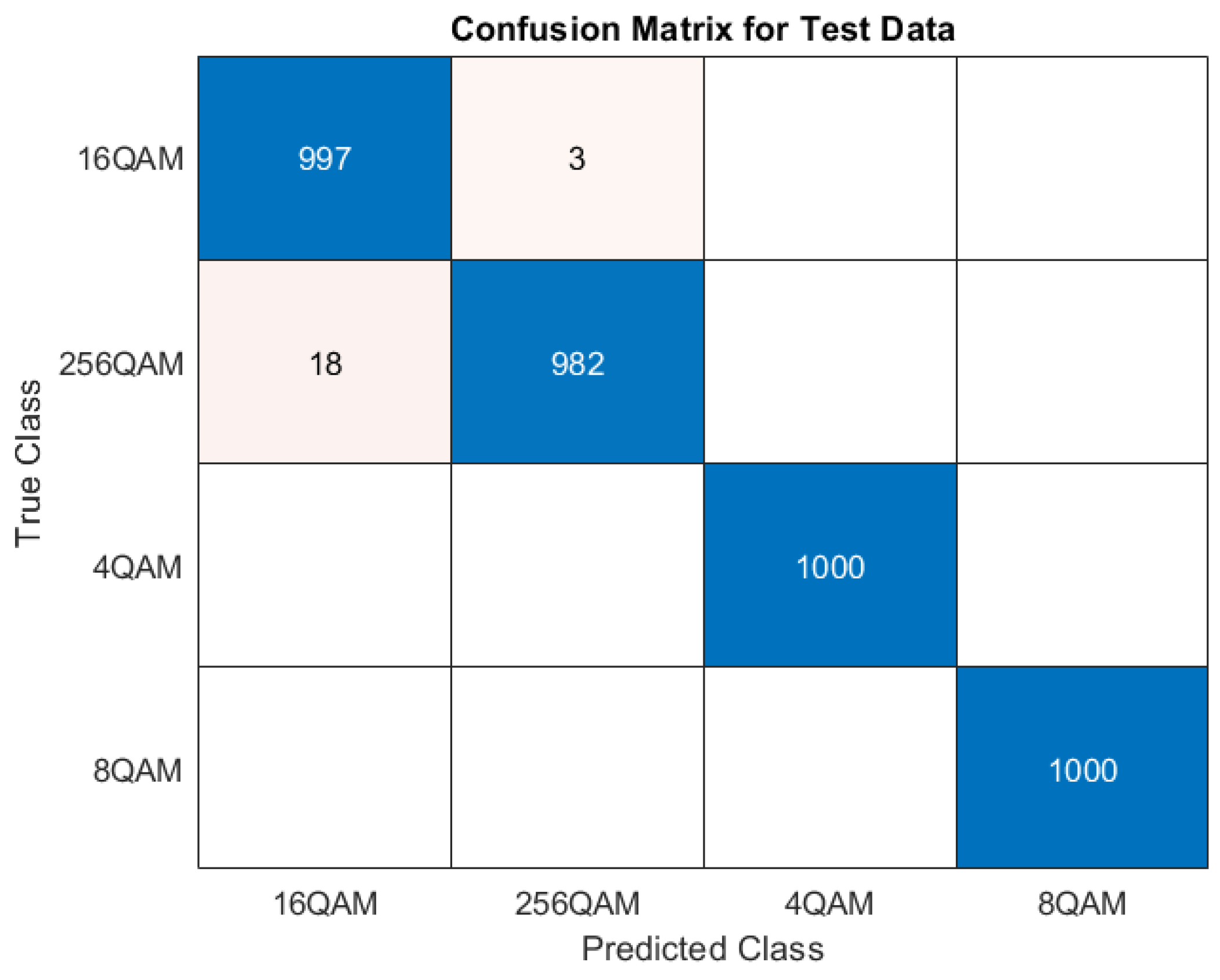

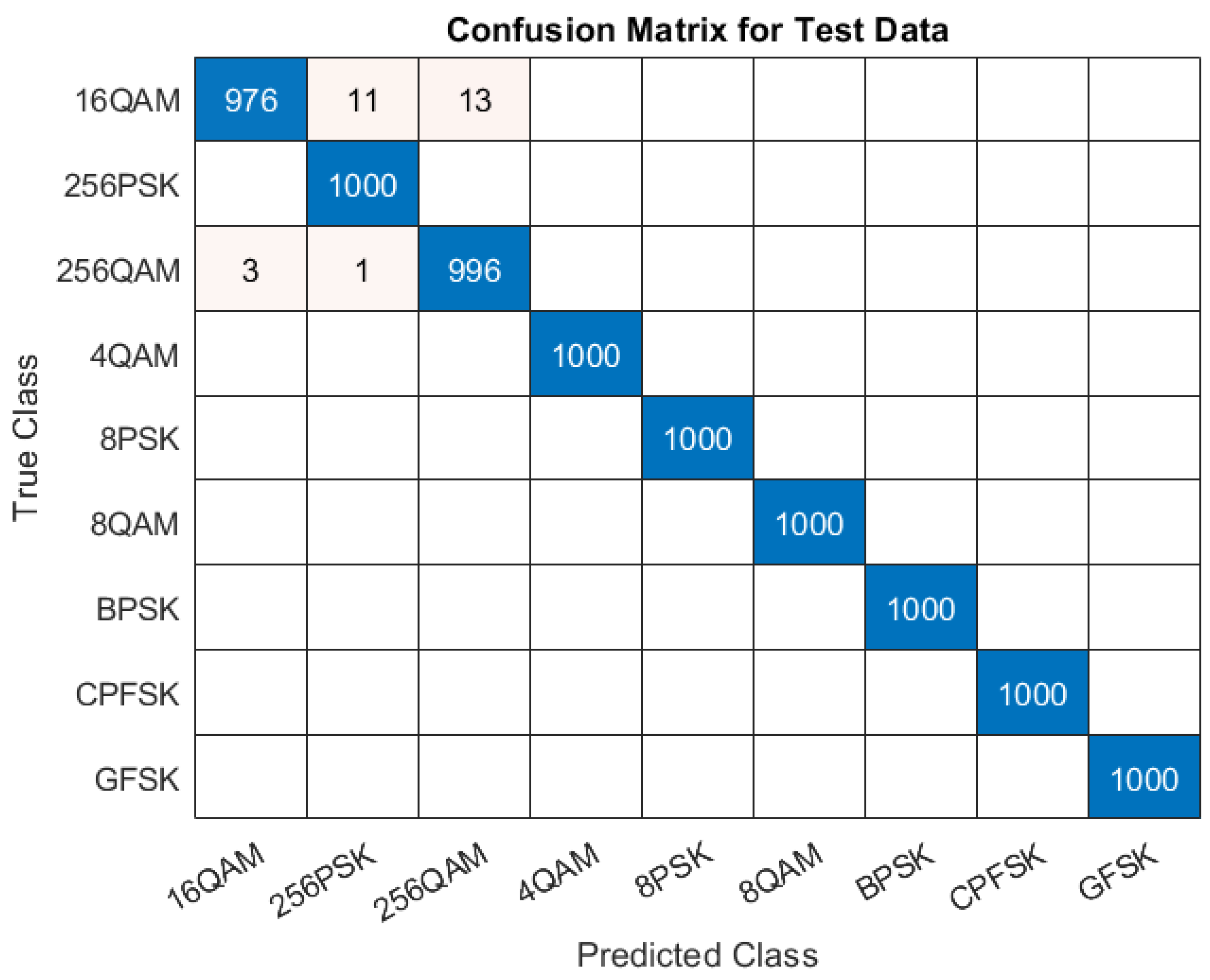
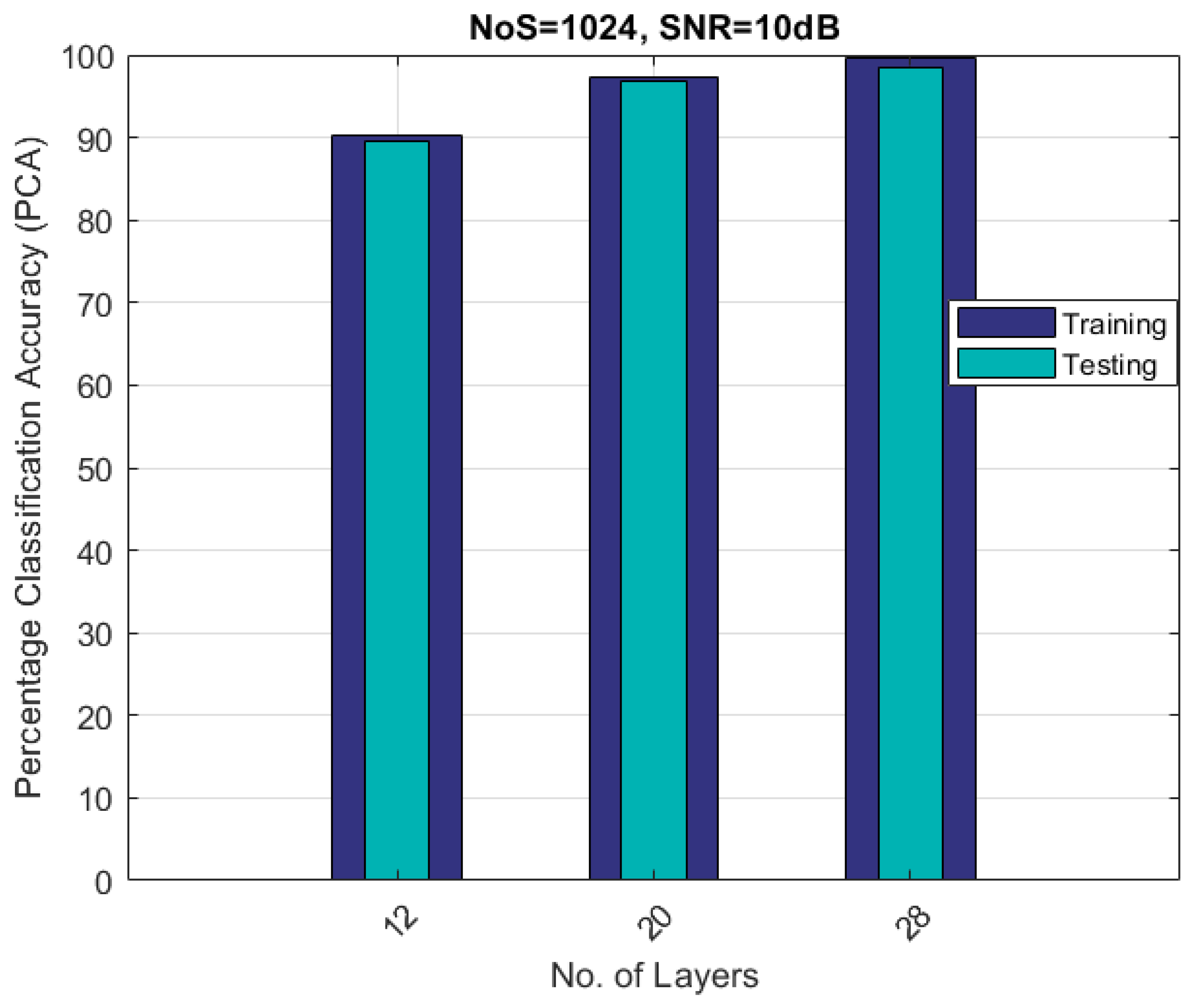
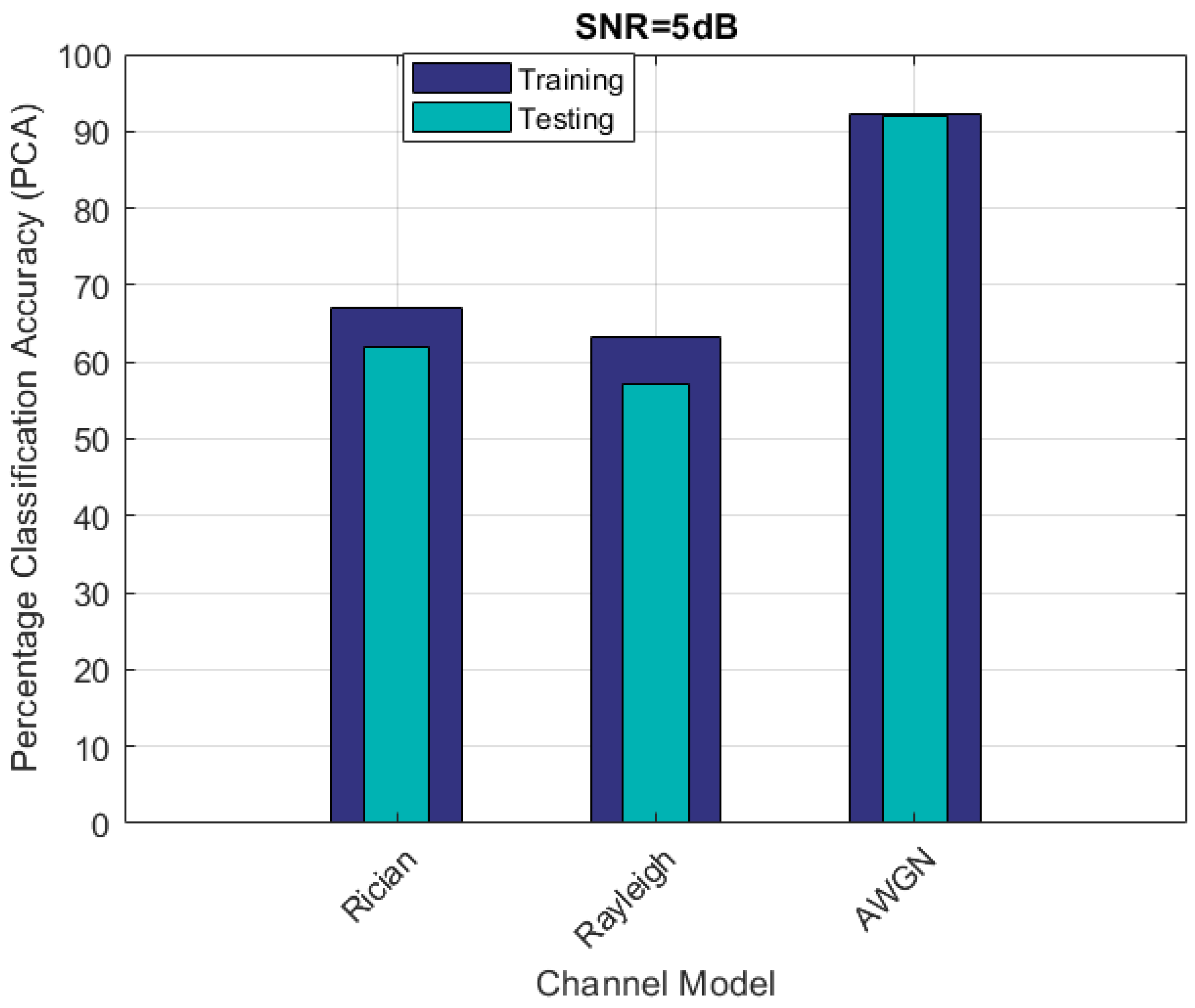
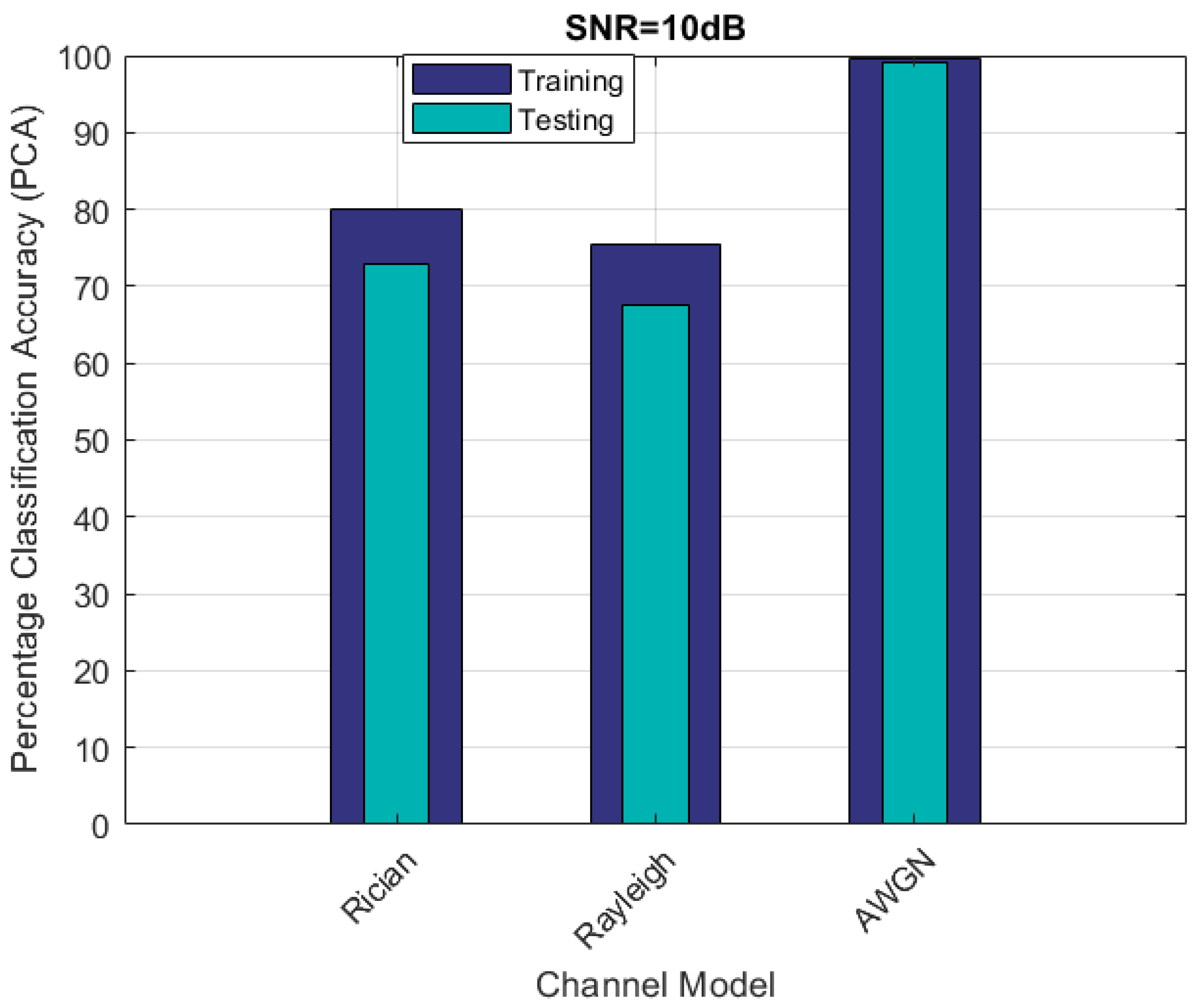

| Layer No. | CNN | Max Pool | Computations |
|---|---|---|---|
| L1 | 32 | 32 | 64 |
| L2 | 48 | 48 | 96 |
| L3 | 64 | 64 | 128 |
| L4 | 96 | 96 | 192 |
| L5 | 128 | 128 | 256 |
| Total | 368 | 368 | 736 |
| Parameter | Value |
|---|---|
| Samples per Frame | 10,000 |
| Training Samples | 80% |
| Validation Samples | 10% |
| Test Samples | 10% |
| No. of Samples | 1024 |
| Sample Rate | 200 KHz |
| SNR | [0, 5, 10] dB |
| Channel | AWGN, Rayleigh Fading, Rician Fading |
| Layer of CNN | 28-Layer Architecture |
| Modulation Schemes | PSK, FSK, QAM |
| Iterations per Epoch | 2500 |
| Number of Epochs | 10 |
| CASE-I | ||
|---|---|---|
| SNR | Training Accuracy | Testing Accuracy |
| 5 dB | 100% | 100% |
| CASE-II | ||
| SNR | Training Accuracy | Testing Accuracy |
| 10 dB | 99.58% | 99.47% |
| CASE-III | ||
| SNR | Training Accuracy | Testing Accuracy |
| 10 dB | 99.80% | 99.68% |
| Modulation | [33] | [34] | [35] | [36] | VB-CNN |
|---|---|---|---|---|---|
| BPSK | 70.9 | 98 | 100 | 96.52 | 100 |
| 8 PSK | 44.6 | 98 | 97 | 97.62 | 100 |
| 256 PSK | - | - | - | - | 83 |
| QAM | - | - | - | 96.42 | 100 |
| 8 QAM | - | - | - | 96.98 | 100 |
| 256 QAM | - | - | - | - | 89 |
| GFSK | 88.8 | - | 94 | - | 100 |
| CPFSK | 96.9 | - | 100 | - | 100 |
Disclaimer/Publisher’s Note: The statements, opinions and data contained in all publications are solely those of the individual author(s) and contributor(s) and not of MDPI and/or the editor(s). MDPI and/or the editor(s) disclaim responsibility for any injury to people or property resulting from any ideas, methods, instructions or products referred to in the content. |
© 2023 by the authors. Licensee MDPI, Basel, Switzerland. This article is an open access article distributed under the terms and conditions of the Creative Commons Attribution (CC BY) license (https://creativecommons.org/licenses/by/4.0/).
Share and Cite
Talha, M.; Sarfraz, M.; Rahman, A.; Ghauri, S.A.; Mohammad, R.M.; Krishnasamy, G.; Alkharraa, M. Voting-Based Deep Convolutional Neural Networks (VB-DCNNs) for M-QAM and M-PSK Signals Classification. Electronics 2023, 12, 1913. https://doi.org/10.3390/electronics12081913
Talha M, Sarfraz M, Rahman A, Ghauri SA, Mohammad RM, Krishnasamy G, Alkharraa M. Voting-Based Deep Convolutional Neural Networks (VB-DCNNs) for M-QAM and M-PSK Signals Classification. Electronics. 2023; 12(8):1913. https://doi.org/10.3390/electronics12081913
Chicago/Turabian StyleTalha, Muhammad, Mubashar Sarfraz, Atta Rahman, Sajjad A. Ghauri, Rami M. Mohammad, Gomathi Krishnasamy, and Mariam Alkharraa. 2023. "Voting-Based Deep Convolutional Neural Networks (VB-DCNNs) for M-QAM and M-PSK Signals Classification" Electronics 12, no. 8: 1913. https://doi.org/10.3390/electronics12081913
APA StyleTalha, M., Sarfraz, M., Rahman, A., Ghauri, S. A., Mohammad, R. M., Krishnasamy, G., & Alkharraa, M. (2023). Voting-Based Deep Convolutional Neural Networks (VB-DCNNs) for M-QAM and M-PSK Signals Classification. Electronics, 12(8), 1913. https://doi.org/10.3390/electronics12081913







